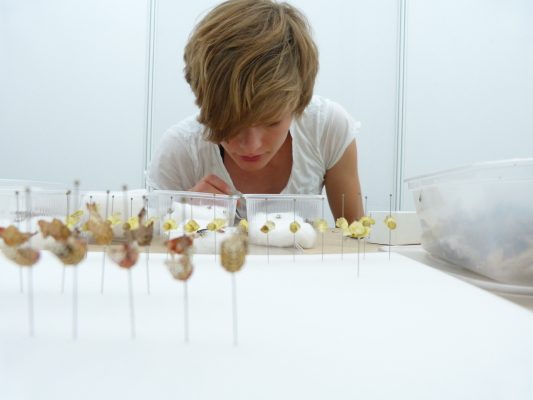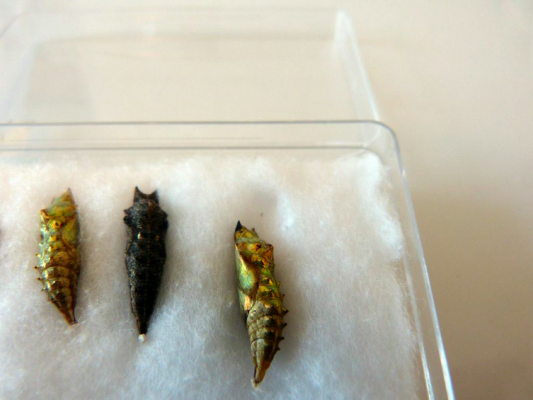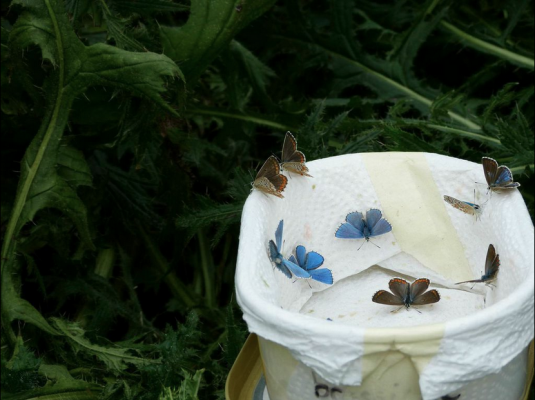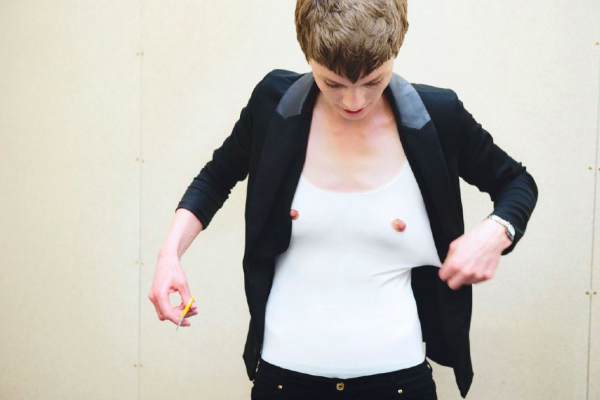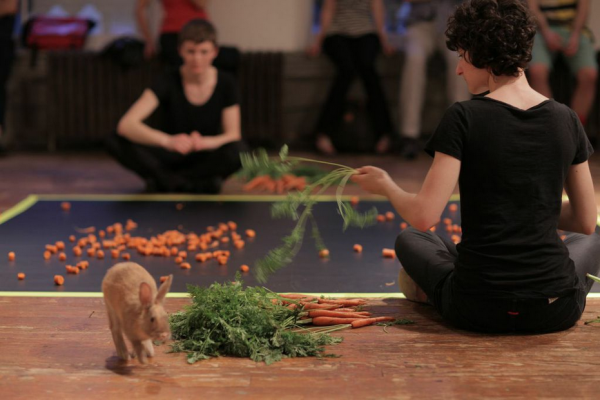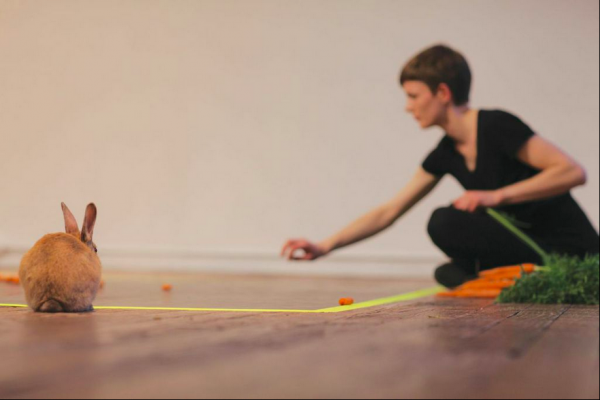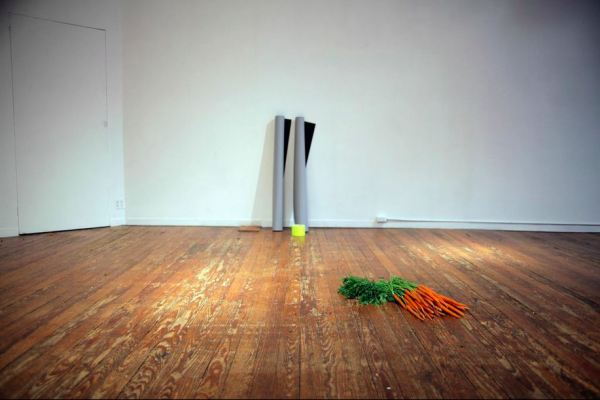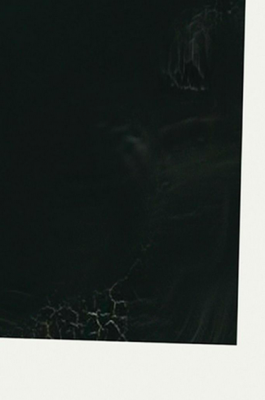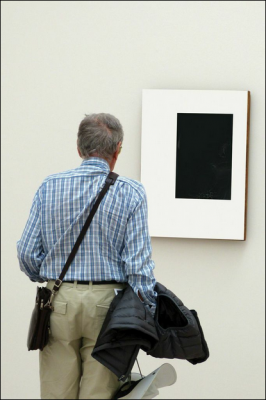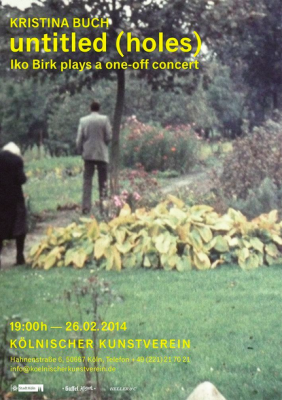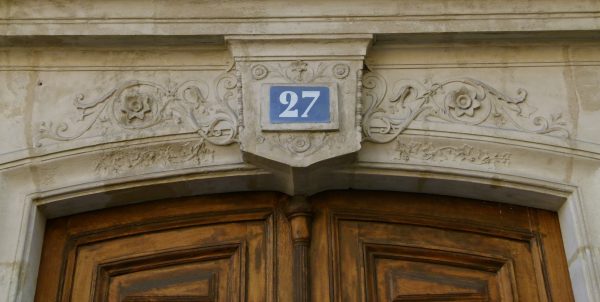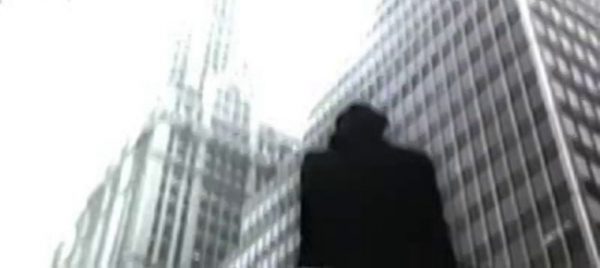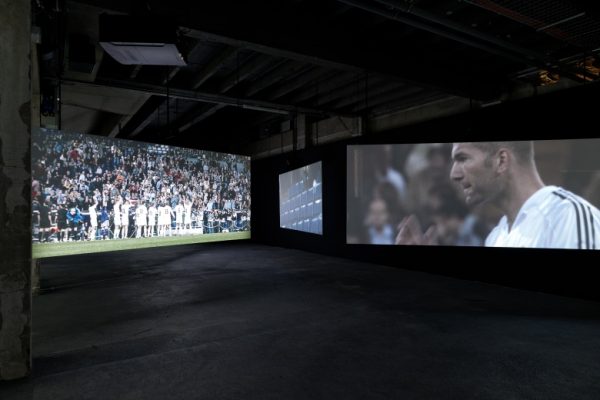There are many ways to make sense of the world, through language, speech and text, but also the senses and their extensions. In his book The Five Senses (Les cinq sens, 1985), Michel Serres encourages his reader to think about touch, sound, taste, smell and sight as continually exceeding the body. The senses knot together as the body meets and interacts with the world. ‘I mingle with the world which mingles itself in me,’ he writes. Silent, the body is saved from its addiction to words. Released, it builds itself anew through sensation.
Kristina Buch’s grandfather stopped speaking aged seventeen. For much of his life he worked on a single musical score, leaving behind exactly one hundred and twenty sheets of notation, for which he provided no clear sequential order. Buch gave her grandfather’s work to composer and musician Iko Birk four years ago. Birk was faced with a challenge: the score had no beginning, middle or end, as a score probably should. It contained, for the most part, unconventional musical notation: small colourful drawings and words, which Buch’s grandfather had erased entirely on twenty-five of the pages, leaving them punctured with small holes. This careful removal is a kind of notation, like the drawings and words. Undoing a gesture creates another. The holes evidence a measured and protracted violence, but they are also openings, physical breaks in the score that offer a personal negotiation of reality up to interpretation and elucidation, translation and narration.
Trained in Biology and Theology, Buch studied Fine Art Sculpture at the Royal College of Art and under Rosemarie Trockel at the Academy of Fine Arts in Dusseldorf. She was the youngest artist to participate in dOCUMENTA 13, and was appointed Assistant Professor at Goethe University, Frankfurt in 2013. Buch tests the rituals and rites associated with people, things, materials and living beings using installations, interventions, video, text, objects, and ‘life-gestures’, as she describes her performances. She also tests the limits of disclosure, what it means for a person or event to be fictional or real. Often, she plants a seed of doubt from which grow other, more personal narratives about being human. What makes a silent man dedicate his life to a single score, and how might another interpret that work?
In February this year, Birk played a one-off concert based on Buch’s grandfather’s score at the Kölnischer Kunstverein. Birk must have read and re-read the score over those years, examined the drawings closely, run his fingertips over its holes. He must have felt an enormous responsibility based on that possession. Four years is a long time to commune with an object in anticipation of a singular event. Then again, maybe a lifetime is not long enough.
The score was shaped during a life lived in silence. He may have withdrawn into silence as he advanced into adulthood, but Buch’s grandfather’s muteness was not necessarily passive. In his silence, perhaps he joins the monks who give their voices up to God in order to speak more directly to a higher power. The oft-quoted narrator of Samuel Beckett’s The Unnamable (1953) muses on ‘the inability to speak, the inability to be silent, and solitude.’ After all, his search for ‘the means to put an end to things, an end to speech, is what enables the discourse to continue.’ Silence, the refusal to speak in a world in which so many don’t have a voice, is a retreat that is also an advance, another way to engage with the corporeal, the world and its matter, and the non-physical world, which is a world beyond language.
In Happy Days, Beckett’s 1961 play, Winnie’s husband Willie’s silence becomes unbearable. Winnie is in a desperate situation, stuck fast in sand up to her breasts. She wishes she could manage on her own, but still she has to know he is there, semi-conscious, speaking in grunts and moans, in order to feel herself. Lots of animals make contact calls, random interruptions in silence, to signal ‘all clear’, or ‘everything’s (still) okay’. As she loses her body to the earth, Winnie talks. Only occasionally does she stumble into silence. She recovers from gaps in her memory through vocal repetitions. She has a number of objects – a hairbrush, toothpaste, a mirror, a gun – but none of them will save her. Despite her mundane chores and the endless days and her sleep deprivation and her dodgy memory of some kind of education, she maintains hope of escaping her reality, a woman’s reality. A bell so violent it makes the sand slip puts off her death, her endless silent sleep. It’s as if the sound is connected to the earth. Buried completely, there is only silence. Finally: no more breasts, and then, no more head, no more voice.
In her essay ‘The Gender of Sound’, Anne Carson quotes Sophokles’s blanket statement: ‘Silence is the kosmos [good order] of women.’ Woman needs to be silenced, her mouth closed, because her speech is continuous with her inside. When she speaks she lets her inner disorder leak out. Hers is a voice that acts ‘like a sign language, exposing her inside facts,’ a direct transcription. Man breaks continuity between the inside and out through the masculine virtue of self-control. She can only be controlled by patriarchy and must be censored by those who can censor themselves: ‘When it is not locked the mouth may gape open and let out unspeakable things.’ Woman wails and cries and shrieks. She makes bad sounds, and pollutes the air with her noise. Her continuity is the basis of the nineteenth-century psychoanalyst’s talking cure. He could analyse her outside to understand her inside because they are continuous with one another. It is a woman’s silence that structures her world. Ideally, all her holes should be closed shut: as above, so below.
What are holes anyway? They are absences, immaterial, but they are also things. We name them, after all. We describe their physical qualities and identify their number, size and location. We call them bore holes, or pits, or pockets, or cavities, through or blind. A hole is something, even though its host and contents define its qualities. Maybe there is no such thing as a hole at all, just a disturbance in matter. Then again, no one would call a gap in a musical score a disturbance. There is always silence in speech; in music, silence is an ordering principle. A score has breaks to mark the beginning of one phrase and the start of another. Rests allow a composer to emphasise certain melodies and refrains.
For her recent work Some at times cast light (2014), commissioned as part of Urbane Künste Ruhr, Buch officially named a public place in Bochum after a fictitious woman. She permanently installed a bronze bust of that woman at the site, and filled an adjacent park with thousands of fireflies, which she had bred herself. The time of the work, the stages of its becoming, was governed by biology (a firefly lives as larvae for two years, during which time it hardly glows at all; as an adult, it glows bright for two weeks before it dies) and bureaucracy (getting a site officially renamed and a sculpture permanently installed). Nature, like administration, imposes its own limits. The bust, as a portrait, suggests that the woman is, or once was, a real individual. A portrait is always a death mask, which captures a likeness as it disappears into lifeless matter. On the other hand, if this woman is a fiction, she is also very real. The bust negates fiction with physical presence. As Buch has said of the bust: ‘she is made up, never existed, doesn’t exist. She is perhaps a lie, a sorrow and a hope in one dress.’
Who deserves to have public sculptures dedicated to them, their likenesses re-made in bronze? Who gets to decide who is remembered in this way, cast into the light produced by a mass of tiny beings before they extinguish into darkness, and do they have to be a real individual? This woman is everywoman, silent and permanent. Hers is a likeness with no original, which appears to comply with the ‘good order’ of women – which is another fiction. She has no body of work to refer to, no lifetime of achievements, which can be named and listed. She exists as brightly, and as briefly, as the fireflies’ light. Without a relationship to any one once-living body, the woman is offered as an image of woman, specific and yet untraceable. The woman is real because she has a name, if not a voice, to which things and places and bugs – or their momentary luminescence – can be dedicated.
Some at times cast light follows Buch’s The Lover, commissioned as part of dOCUMENTA 13 in 2012. Buch made a scaffold garden filled with indigenous plants, which she visited every day. She brought butterflies with her, hatched in her flat, which were free to stay in the garden or fly away. Her devotion to an insect’s life in the open was also a commitment to a fiction, to something seemingly absurd, a temporary site built as a home, at once natural and artificial, which nonetheless refused to be filled up with inhabitants. Buch is recast as lover and mother, shaped and transformed through weeks of devotion. She spent her time at dOCUMENTA nurturing creatures that behave according to their own biological needs: butterflies do not stay in a garden out of reciprocal love; nor do they leave out of its lack.
Iko Birk’s performance of Untitled (holes) in February at Kölnischer Kunstverein was not recorded, and it will never be re-performed. You had to be there. Tickets were limited and pre-booked via email, but I, like many others, received a message, an automatic apology politely informing me that there were no tickets left. My own desire to witness, to be there at the concert, filled up with live sound, was overcome by the limitations of the artwork, imposed by Buch herself. I was never in possession of a ticket, a pass to witness the one-off event, but it still felt like a loss.
A thought occurred to me recently: 120 pages total, twenty-five pages of erased notation – the score’s math is neat for something so messy, the rubbing out and the unnumbered pages, the grandfather’s unexplained silence. If an event has a real effect, presumably it doesn’t matter if you were there or not. My desire to be there was real enough.
I can’t find any reviews of the concert, any testimonials, if testimonials are a kind of evidence of occurrence, of reality. I am looking at photographs of Buch with her nipples poking through her shirt, taken during her life-gesture Sole Marie Sits at Temporary Gallery, Cologne, in 2013. There is no such documentation of Iko Birk on stage. There is only the listing for the concert on the website of the Kölnischer Kunstverein, the flyer taken away by those who turned up just in case there were tickets on the door, the email in inboxes such as my own. Buch’s own voice is clear and yet unpredictable. She monitors and interferes with the processes and rituals of living beings, institutions and governing bodies. She involves her own desires and narratives in her negotiation of the natural and un-natural, insects and plants, galleries and institutions, governing bodies, technologies, and the means by which we share and receive information. By mingling with these structures, which mingle with her in turn, Buch alters and is altered by the world.
